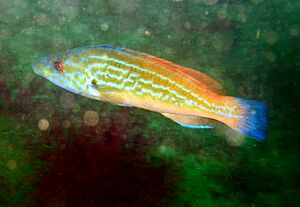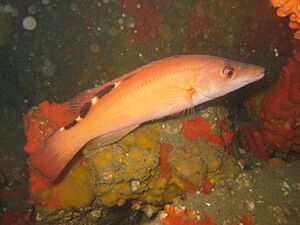Cuckoo wrasse facts for kids
The cuckoo wrasse (Labrus mixtus) is a colorful fish found in the eastern Atlantic Ocean. You can spot them from Norway all the way down to Senegal. They also live in the Mediterranean Sea. These fish usually hang out in rocky areas with lots of plants, often between 40 and 80 meters (about 130 to 260 feet) deep.
People sometimes catch cuckoo wrasse for food, but they are more popular for sport fishing. They are also a favorite fish to see in public aquariums because of their bright colors.
Quick facts for kids Cuckoo wrasse |
|
|---|---|
 |
|
| Adult male cuckoo wrasse | |
 |
|
| Female cuckoo wrasse | |
| Conservation status | |
| Scientific classification |
Contents
What Does a Cuckoo Wrasse Look Like?
The cuckoo wrasse has a long, pointed head. Its body is thinner and longer than its cousin, the ballan wrasse. Both fish live in the same areas of the Atlantic Ocean.
Cuckoo wrasse are very colorful fish. Males and females look quite different from each other. Young males and all females are usually pink, orange, and red. Females have three black spots near their tail, behind their dorsal fin. These spots have white areas between them and stretch to the tail. Males do not have these spots.
Adult male cuckoo wrasse have blue heads and orange bodies. They often have blue stripes and patterns along their bodies. Their fins also have blue lines on the edges.
Like the ballan wrasse, the cuckoo wrasse has a small mouth. It has thick, folded lips and a single row of sharp, canine-like teeth. Male cuckoo wrasse can grow up to 40 centimeters (about 16 inches) long. Females are smaller, reaching about 30 centimeters (about 12 inches). The average male is about 30 centimeters long.
Their long dorsal fin is the same height all the way along its length. This fish also has large scales, which are bigger than its eye pupil.
Where Do Cuckoo Wrasse Live?
Cuckoo wrasse live in the northeast Atlantic Ocean. You can find them along the coast of Europe, from Norway south to Spain. They also live along the Atlantic coast of North Africa, down to Senegal. They are found near the Canary Islands, the Azores, and Madeira.
Their range extends into the Mediterranean Sea as far as Cyprus. They are common there. However, they are not found in the easternmost part of the Mediterranean, called the Levantine Sea.
Cuckoo Wrasse Habitat and Life
Cuckoo wrasse prefer rocky areas and other hard surfaces. They live among algae at depths from 2 to 200 meters (about 6 to 650 feet). However, they are most commonly found between 20 and 80 meters (about 65 to 260 feet) deep. They also like areas with coralline algae.
These fish prefer slightly deeper water than the ballan wrasse. They only sometimes come into very shallow waters near the shore. In the Azores, adult cuckoo wrasse are usually not seen above 50 meters (about 160 feet) deep. Young cuckoo wrasse might be found in shallower waters sometimes.
Cuckoo wrasse are usually found alone or in pairs with young fish. They lay eggs, which means they are oviparous. The female can lay up to a thousand eggs in a special nest. The male builds this nest from algae and then guards it.
An interesting fact about cuckoo wrasse is that they are protogynous hermaphrodites. This means that females can change their sex and become males! This process takes about seven months.
Their main diet consists of crustaceans, like crabs and shrimp. They also eat small fish, molluscs (like snails), and worms.
Why Are They Called Cuckoo Wrasse?
The name "cuckoo wrasse" comes from fishermen in Cornwall, England. They thought the blue markings on the fish looked like bluebell flowers. In the Cornish language, a bluebell is called bleujenn an gog, which means "the cuckoo flower."
The cuckoo wrasse was first officially described by Carolus Linnaeus in 1758. He was a famous scientist who named many plants and animals. He said the fish came from "Liburnia," which is now Dalmatia, Croatia.
Cuckoo Wrasse and Humans
People sometimes eat cuckoo wrasse, but their meat is not very popular in many places, like Britain. So, there isn't a big demand for them from commercial fishing boats.
However, recreational anglers (people who fish for fun) do catch them. Since these fish live for a long time, too much fishing can harm their populations. Because of this, many anglers practice catch and release. This means they catch the fish and then let them go.
In Norway, cuckoo wrasse and other types of wrasse are used in salmon farms. They help by eating tiny parasites called salmon lice off the farmed fish. This practice can sometimes lead to too many wrasse being caught in certain areas, causing their numbers to drop.



